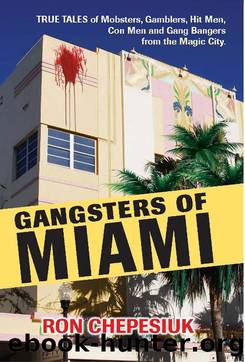Gangsters of Miami by Ron Chepesiuk

Author:Ron Chepesiuk [CHEPESIUK, RON]
Language: eng
Format: epub
ISBN: 9781569801407
Publisher: Barricade Books
9
Gangsters in Blue
BY THE EARLY 1980s, Miami was more like the âDisaster Cityâ than the âMagic City.â It had a multitude of problems, and most of them could be attributed to the rampant violence and corruption associated with the booming Latin American drug trade. During the early 1970s, as the drug trade grew, the Greater Miami region became the port of entry for perhaps 75 percent of all the cocaine and marijuana being smuggled into the United States. As Stanley Marcus, the U.S. attorney for the Southern District of Florida, explained in a May 1984 Miami Herald article, âIt was in South Florida that the criminal transactions of much of the American drug trade was taking place.â
Savage drug wars over the riches of the cocaine trade were leading to shootouts in suburban malls and a daily litter of corpses. Officials from prominent Miami financial institutions were being indicted for their greedy grab of some of the $3 million in laundered drug money flowing daily through the Miami banking system. Over a nine-month period in May 1980 Castro had emptied his jails of criminals and the mentally ill, and many of the so-called Marielitos were walking the Miami streets looking for trouble. In the early 1980s the new gangsters on the block were committing one-third of Miamiâs murders as the crime rate skyrocketed.
Miamiâs shell-shocked citizenry demanded that the police do something to stop the violence, killing, and mayhem. The cityâs municipal government responded by doubling the size of the police force, hiring about 600 fresh recruits between 1980 and 1982. It was about time, for the city had not hired a police recruit in five years. Yet in the rush to recruit, most of the new policemen were not adequately trained or supervised; indeed, fresh-faced police officers with less than three yearsâ experience had to become field training officers, responsible for deciding whether the new recruits joining the police force should pass probation. If the police departments in Miami and in Dade County had done a thorough check, they would have found that more than a few of the recruits had been gang members while in high school and some had even committed thefts and other kinds of larceny.
Investigators later found that at least one fox had been guarding the hen house. Joaquin Miranda, whom the police assigned to conduct background checks on new recruits, was himself associating with drug dealers. Further, in at least six cases Miranda had left out of the reports potentially damaging information about the recruits, including their use of illegal drugs.
Some of the recruits had gone through the academy with reading skills as low as the fifth grade level, forcing the city to institute remedial reading and writing classes. The lack of basic literary skills led to some strangelyâeven funnyâwritten field reports. One young officer wrote that a victim had been âbitten on the headâ when he actually meant to write âbeaten on the head.â Another police officer wrote up a traffic accident to read that the car had âsquid marks,â not âsqueal marks.
Download
This site does not store any files on its server. We only index and link to content provided by other sites. Please contact the content providers to delete copyright contents if any and email us, we'll remove relevant links or contents immediately.
| Espionage | Hoaxes & Deceptions |
| Murder & Mayhem | Organized Crime |
| Serial Killers | White Collar Crime |
Mindhunter: Inside the FBI's Elite Serial Crime Unit by John E. Douglas & Mark Olshaker(9206)
Wiseguy by Nicholas Pileggi(5674)
Room 212 by Kate Stewart(5040)
Hitman by Howie Carr(5021)
Secrecy World by Jake Bernstein(4651)
Killers of the Flower Moon: The Osage Murders and the Birth of the FBI by David Grann(4387)
Papillon (English) by Henri Charrière(4199)
Breaking Free by Rachel Jeffs(4175)
Killers of the Flower Moon by David Grann(3971)
Say Nothing by Patrick Radden Keefe(3903)
American Kingpin by Nick Bilton(3759)
The Secret Barrister by The Secret Barrister(3615)
Molly's Game: From Hollywood's Elite to Wall Street's Billionaire Boys Club, My High-Stakes Adventure in the World of Underground Poker by Molly Bloom(3486)
Mysteries by Colin Wilson(3397)
In Cold Blood by Truman Capote(3311)
Signature in the Cell: DNA and the Evidence for Intelligent Design by Stephen C. Meyer(3075)
I'll Be Gone in the Dark by Michelle McNamara(3024)
Rogue Trader by Leeson Nick(2977)
Bunk by Kevin Young(2950)
